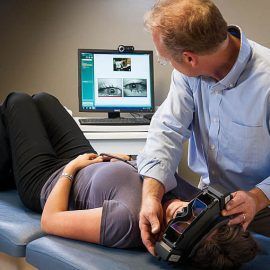VESTIBULAR REHABILITATION
What is Vestibular Rehabilitation?
Vestibular Rehabilitation is an exercise-based program, designed by a specialized Physical Therapist, to improve balance and reduce dizziness-related problems. Typical patients are those diagnosed with dizziness, imbalance, vertigo, Meniere’s syndrome, benign paroxysmal positional vertigo, neck-related dizziness and migraines, and those who have had a stroke or brain injury or who frequently fall.

INFORMATION ON DIZZINESS
Dizziness can be described as:
- Feelings of unsteadiness
- Wooziness (swimming feeling in head)
- Lightheadedness
- Feelings of passing out
- Sensations of moving
- Spinning
- Floating
- Swaying
- Tilting
- Whirling (sensations known as vertigo)
These feelings or sensations can occur when you are standing still, lying down, or changing positions. The symptoms can be constant or episodic in nature, only lasting seconds, minutes or hours.
What causes dizziness?
Each year, more than 10 million patients visit a physician due to dizziness. It is the most common complaint of patients over the age of 75, but it can occur in patients of any age.
Dizziness is generally not serious, but is often a sign of a mechanical problem. Dizziness can be due to an inner ear disorder, a side effect of medications, a sign of neck dysfunction, or it can be due to a more serious problem such as a brain or a heart problem.
(Data retrieved from MayoClinic.org, 2018)
VESTIBULAR REHABILITATION
Who benefits from vestibular rehabilitation?
Patients typically referred for vestibular rehabilitation therapy are those diagnosed with dizziness, imbalance, vertigo, Meniere’s syndrome, benign paroxysmal positional vertigo (BPPV), neck-related dizziness, and migraines. Other candidates are patients who have had a stroke or brain injury or who frequently fall.
Common symptoms that can be helped with vestibular rehabilitation include:
- Dizziness or blurry vision with head movements
- Neck tightness, stiffness, and/or pain
- Imbalance or the need to hold onto objects when walking
- Headaches
- Frequent falls
- Generalized “dizziness, wooziness and foggy head” feelings
- Vertigo/spinning
At your appointment, a physical therapist will evaluate your symptoms and review your medical history. Your assessment will include all or part of the following areas:
- Balance and/or leg strength/flexibility
- Gait (how you walk)
- Visual stability and mobility
- Neck mobility and neck and arm strength
- Positional testing, including an inner ear exam
Plan of care:
Based on the findings, a plan of care is developed. The goal of your treatment plan is to improve any deficits that were identified. This, in turn, will improve your ability to function in activities of everyday living, reduce your risk for falling, and ultimately, improve your quality of life.
How successful is vestibular rehabilitation therapy?
Many times, vestibular rehabilitation therapy will be the only treatment needed. Other times, it is a part of the pre surgery/post surgery treatment plan. In most cases, if patients continue to perform the exercises they have learned, balance and dizziness problems decrease significantly or completely disappear.